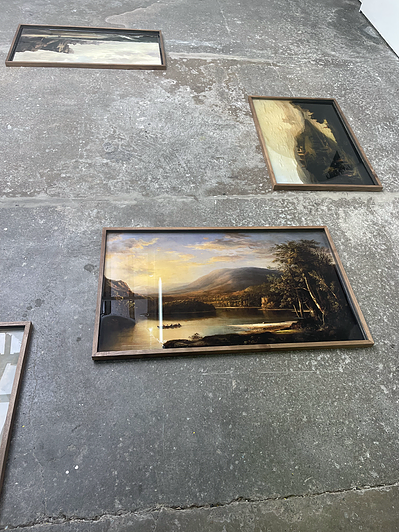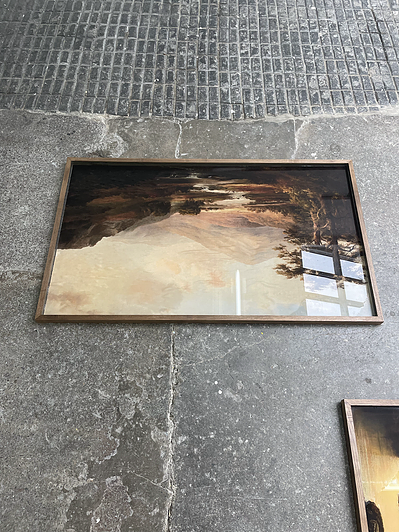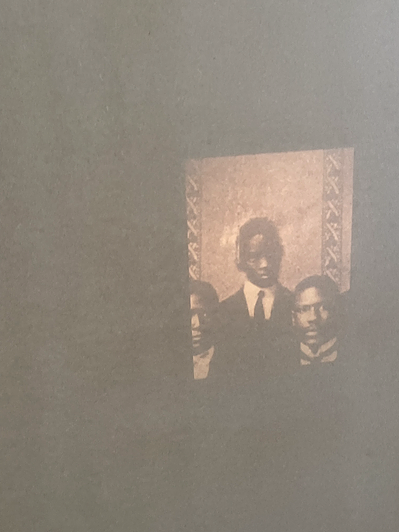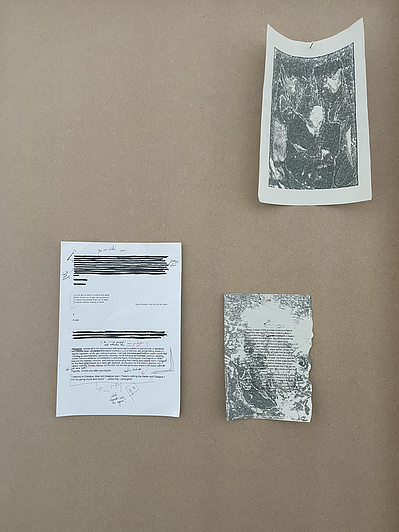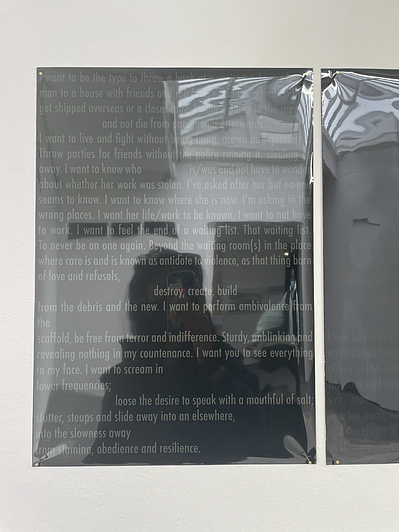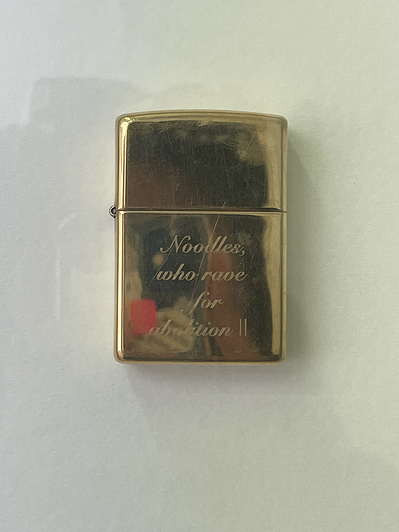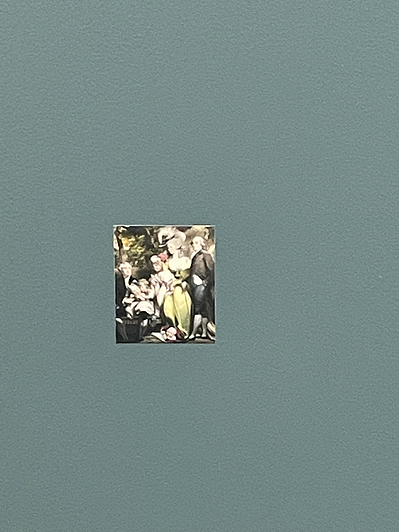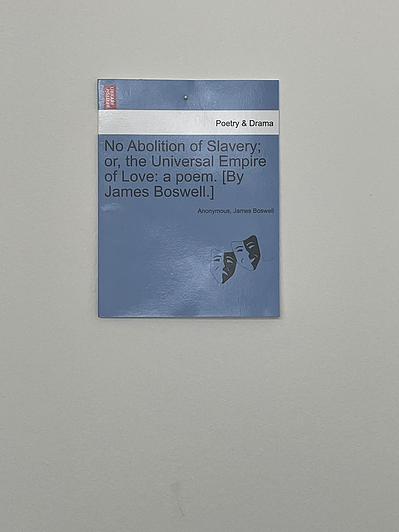a rant! a reel!, Camara Taylor @ Cubitt
Emoji summary: 💧 🖇️ ↩️
I think there is something so tender, soft and vulnerable in showing at an in-between. Stopping point, when the river rushing around you pauses, if only for a moment. I went to see <a rant! a reel!>, Camara Taylor’s show at Cubitt, and the third part of Languid Hands’ programme there, called <No Real Closure>.
As you walk in, there are four classic landscape paintings laid out across the floor. The frames are high lipped, and they have pools of water collecting in them; ripples tremble across gently as you walk round. The paintings are by Robert S Duncanson, an African American painter from the 1800s. There’s a big blue wall at the far end, and behind it a slide projector flips through old photographs of Black students at the University of Edinburgh in the 1900-50s. The back of the wall is mdf beige, and there are three pages stuck up on it, a bit above eye level. One is an annotated A4 printout with Nina Simone lyrics and 2 other quotes I can’t place. The second looks like it has been torn from a book, with a murky green print pressed over top. It goes scrunchy and crackly by the text, but I can just make out something about the race riot on the Clyde, and the words ‘burn it the fuck down, start again’. The third is the print, with a thick white border. There are a couple of other bits stuck up on the walls around the room at different points. A British Library booklet of ‘No Abolition of Slavery; Or the Universal Empire of Love’ by James Boswell (a poem from 1791, in which Boswell mocks prominent abolitionist figures like William Wilberforce, and suggests a pro-slavery argument) is nailed up on a wall, unopenable. A zoomed alllllll the way out Gmail thread sits in a light pine frame. Opposite, a gold zippo lighter sits in a frame too; it is engraved in fancy cursive writing that reads ‘Noodles who also rave for abolition’. Two dark shiny pages of text, too glossy to read clearly, but the text is tumbling and aching; about wanting to do these daring defiant acts, lure a man to a house and rob him, throw a book at a racist teacher, dance in the snow - it is obscured by the strips of light from the window overhead. Five frames overhead too; 2 black and white photos, and 3 one liners with a word blocked out. On the very bottom of the teal-blue wall, there is a very small, very discrete classical painting stuck right out of eye line.
As I made my way back home, this show felt like a buzzing hum way back in the base of my head. Between all those points, I felt myself slipping against the surface of it; like there were 7 things on a table and I had to figure out how they knew each other, how they related and fit together. So that’s the tone I want to take on for this review; I want to link those things up like join the dots.
I am going to line up some things on a table: From the handout: Camara Taylor is an artist based in Glasgow; the show is a paused screen that’s popped out of their ongoing research, ‘that uses ‘silt’ and the process of ‘desilting’ as both metaphor and methodology to examine Scotland’s intimate entanglement and key roles in the development of the current global order’. If we think about art as a method of speaking, uttering or voicing, this exhibition is figured in ‘registers that elide detection, provide cover… networked modes of refusal that don’t necessarily engage in a direct speaking back/to power, but rather a talking elsewhere.’ That low register, that buzzing hum rumbling away, is part of a wider considered movement to handle the speech of exhibition-making. ‘The works in the exhibition are gestures, experiments and nods to these slippery histories and their contemporary manifestations.’
1: silt/desilting
2: cover/off-centre
3: gesture
In an interview alongside the handout, Camara speaks about the specific history of Glasgow, the Clyde and building empire. They speak about how the Clyde was de-silted, widened so that ships could unload further inland. This physical transformation turned Glasgow into the world’s centre for shipbuilding, the Second City of Empire; ships would go from Glasgow straight through the North Sea on a fast-track to the Americas, and avoid Europe and its landlocked complexity. In softer, implicit ways, this physical process transformed Glasgow as a city, as a port city, as an industrial city with complex infrastructure and economic capacity. It is also a physical process that has a harder, visible and lasting transformation; on Google Earth, you can see the river has been widened, it is explicitly visible as a scar. What if you slowed down your breathing and mirrored the movements; silt/desilting as a process of widening, physical transformation, mass movement and collection. What if this was a strategy, or a filter to push things through? Pause screen and push research through this filter to widen - it, us, your own thinking. Ahhhhh - then exhibition becomes an active site, a process of thinking through display.
More things on the table:
4: Robert F Duncanson/romantic landscape painters and the construction of the countryside (as an image, as an imagined space)
5: William Davidson/the son of the Scottish Attorney General of Jamaica and a Black woman, who was executed in 1820 for his alleged role in the Cato Street conspiracy, an attempt to assassinate the Prime Minister and his cabinet.
Camara uses the phrase ‘mobile figures’; those single individuals that slide about through history, that pop up as exception and notable figure. They say, ‘exploring the lives of these mobile figures became an entry point… Finding records of everyday people, history, from below…’
6: British Honduran/Belizean forestry workers who were stationed in Scotland during WW2
7: on, on and on, collecting, relating, sitting with it, pausing.
How can art engage with history? I feel like that is such a loaded and febrile question, especially now, especially as a political question. But remove that. What is art capable of doing in relation to history? Does it have to be a tool; a way to construct narrative, linear, productive? Does it have to be a buckle, a staple, holding things together? I think in this show, art is a container. If I want to link the things up, like join the dots, then I am only joining them together with the wave of my hand, with a gesture. I’m not leaving any marks, I am only pointing. Like a critical vessel through which other shapes are warped, pressure is released, and things can be held closer to us. No longer just history, or object to interpret, understand; now it’s got character for you to meet on level terms, palpable atmosphere to move through, experience, relate to. It, whatever ~it!~ is, can be transformed, widened. Ahh ahhhh ahhhhhhh - exhibition can be soft, mid-point, art can be liquid! Maybe that is what theorists mean when they talk about art as an expanded field.
Tender and melting, this show feels like the antidote to the gallery-related-stress I keep writing around. I am not that bothered by the idea of traipsing about to look at finished articles, but there is something so precious about seeing work when it isn’t quite polished or conditioned - and not even meant to be. Like a baby’s head, how the skull is still soft at the top, still waiting to harden and form. It makes me want to move slowly and carefully, it makes me want to whisper. I think before the pandemic, I’d have looked at this in-between and said, ‘ah yes, I love it when artists play with opacity!’ Like this tender indefinite state was a wall to stop up against, a line to toe and not push past without being rude. I was happily wrong, and I shudder at the goodness I missed. Because there is something worthwhile - textural, sticky and liquid - in turning on the spot, arranging what you’ve got on you into an assembly that makes sense in the moment. That is so Felt and Intuited, and it throws up so many possibilities. I am glad to find these things to wash over me, glad I don’t know what it is, what to call it all. I am happy to have a looser grip, no end point, palpability, liquid sprawling.
a rant! a reel! is on at Cubitt until 19th September. Coinciding with this show,, Camara is also premiering a film, holus-bolus, online at Edinburgh Art Festival. It's available until 29th August.
'As entry to the exhibition is free, and many of us have a renewed commitment to mutual aid, we ask those that are able to donate any amount, big or small, to Glasgow-based MORE (Migrants Organising for Rights and Empowerment), a group of migrants and members of the community campaigning for the right to work, study, good housing and to be treated with dignity. Donate to their Climate Justice Is Migrant Justice fundraiser here.'
^^ The handout mentions this, and since we get a few new patrons every sunday, if you were considering signing up to our Patreon this month, pls consider putting it off for a month n donating to MORE's Climate justice fundraiser instead :)
